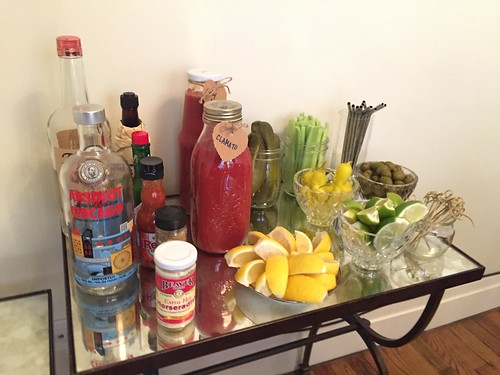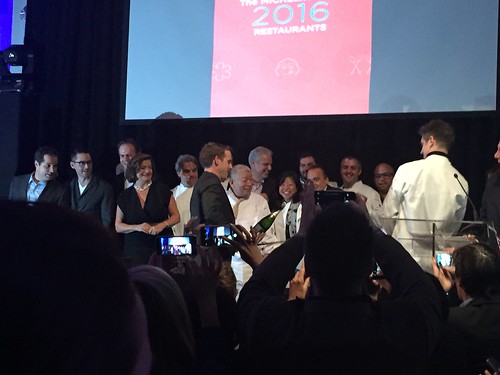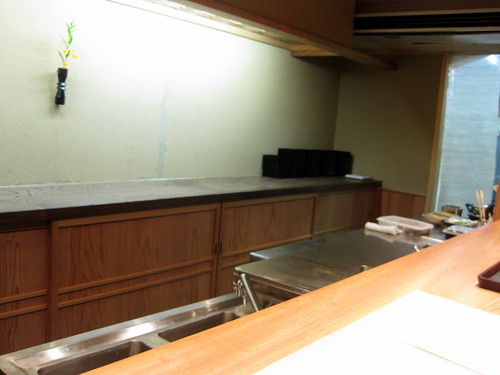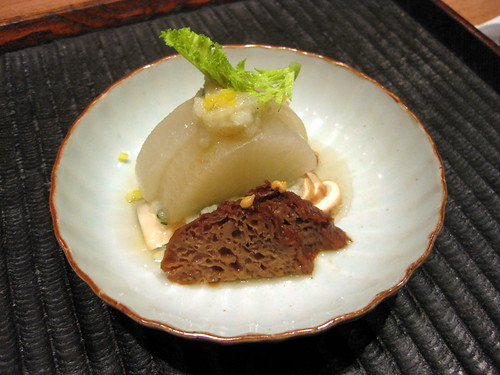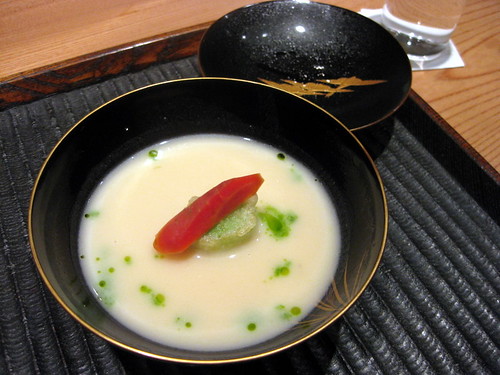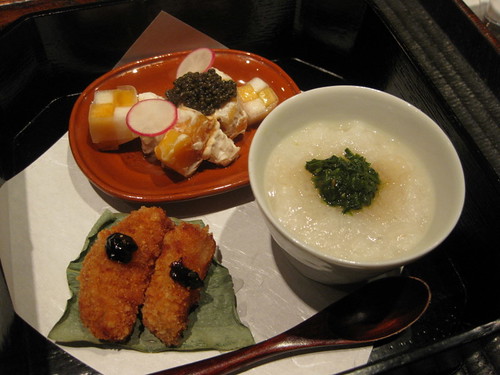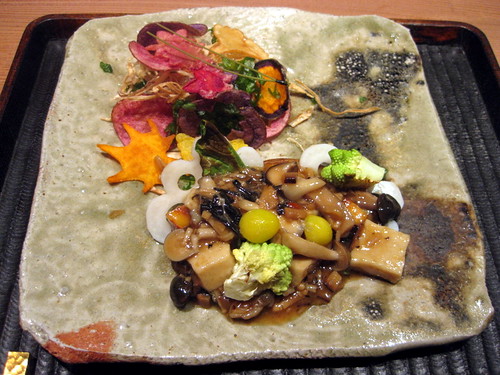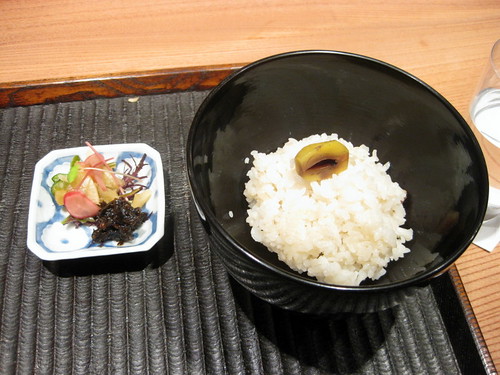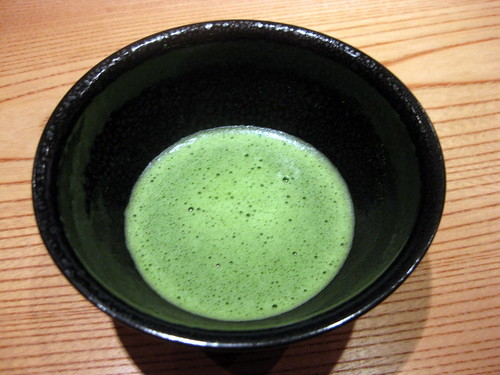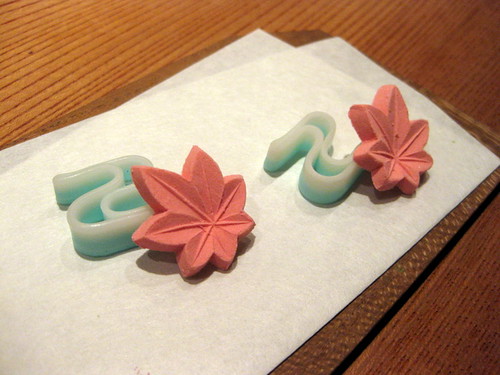Kajitsu
Under: Asian,Desserts,Dinner,East Village,Japanese,Michelin 2010 Guide,Michelin 2011 Guide,My Life,Prix-fixe


Kajitsu, in the East Village, specializes in Shojin cuisine which was developed by Zen Buddhists and believes in the Buddhist principle of not taking life (and more importantly for us, it means it’s a restaurant that doesn’t use meat or fish). A Michelin-starred restaurant that only serves vegetables and non-meat items must be an incredible restaurant, right? I mean, having a restaurant specialize in vegetarian cuisine that doesn’t make you miss meat is a daunting task and being Michelin-ranked is even more impressive. My friend from college, Melany, was in town for work and we met up for dinner and to catch up:
We sat at the bar so we could watch the chefs in action and ordered the hana, their seven course tasting menu. The prep area was very clean and minimalistic:
Our first course was Braised Daikon Radish with Rikyu-Fu and Matsutake with Grated Daikon, Daikon Leaves, Yuzu:
The wheat gluten (in the front) served as the protein in this very light and delicious start. The daikon was lightly stewed and all of the flavors really stood out separately but also came together very well.
Our next course was the Puree of Parsley Root and White Miso Soup with Leek Tempura Kintoki Carrot:
The carrot added just enough sweetness to the very delicately flavored soup; I was worried that it was going to be really plain but it was actually quite flavorful and full-bodied.
Next, we had Fresh Persimmon and Kabu Turnip with Sesame Cream and Tonburi, Rice Paper, Breakfast Radish, Rice Porridge with Tea Leaves and Lotus Rootlet, Lotus Seed, Ume Paste, Ginger, Scallions, Fried Sunchoke with Sweet Red Miso, Multi Grain Cereal, Shichimi Pepper:
And the porridge without the gingko leaf:
The dishes signified the changing of the seasons; persimmons are eaten a lot during this time of year and porridge is something warm and filling that I eat all year round but it’s especially comforting when it’s cold outside. The gingko leaves were hand-picked and placed on the porridge, which added a really beautiful touch to the presentation of the dishes. The porridge was slightly bitter because of the tea leaves and I wasn’t a huge fan of the persimmon dish because it also included sesame paste and made the persimmon taste muted.
Next, we had House-Made Soba with Dipping Sauce, Scallions, Wasabi:
Melany’s dad makes the dish a lot because it’s simple yet very gratifying; also, when I read reviews of Kajitsu, everyone spoke really highly of their house made soba. I enjoyed the dish but didn’t think it was the highlight of the meal.
My favorite dish of the night was probably our next course – Fallen Vegetable Leaves with Baked Sweet Potato, Beets, Purple Carrot, Burdock Roots, Ginko Nuts, Chrysanthemum Leaves, Steamed Awa-Fu with Assorted Autumn Mushrooms, Fried Potato:
The presentation was really beautiful and colorful (and all of the plates they used were absolutely gorgeous) – I really loved the attention to detail of each fall-shaped leaf! Under the fallen leaves was a small Japanese potato that was wrapped in aluminum foil – kind of like a treasure hunt! The assorted mushrooms were stewed with more of the wheat gluten and provided a really filling dish that was a nice contrast after the soba.
Next, the chef brought us out sesame tofu marinated in white miso (for three months) with shaved truffle and a glass of sake:
Melany had a different sake glass that I thought was very cute:
The tofu was kind of pungent and the server explained that the tofu is marinated under ground for three months before they dig it up and serve it; it’s not on the menu but our chef liked us enough to give us the extra dish.
Next, we had our last savory dish – Chestnut Rice with Macadamia Nuts Powder with Sesame, Parsley and House-Made Pickles:
And the macadamia nut powder:
The dish was simple but very comforting; the rice with hints of chestnut tasted like fall and the macadamia nut powder added a slight sweetness to contrast with the simple house pickles.
For dessert, we were given Sweet Kabocha Ball with Azuki Bean Paste and Dried Cranberries:
While we were eating our dessert, the chef began preparing our matcha tea:
He started by pouring hot water in each of the bowls and swirling the water around. At first I thought it was to prepare the water to the perfect temperature, but then he threw out the water (I think it was to heat up each bowl). Then he spooned in a scoop of matcha green tea powder, filled up the bowl with water, and began whisking the green tea before serving it to us:
Around the same time, the server brought along sugar candies by Shioyoshiken:
The candies tasted like microscopic granules of sugar and weren’t as delicious as they were nice to look at, but it was a nice way to round out the meal.
Melany and I really enjoyed the meal at Kajitsu and I also thought the service was very thoughtful but not imposing. The meal at Kajitsu was one of the better one-starred restaurants I’ve visited this year and I can see why the restaurant would move from the one-star category to the two-star category. I recommended the restaurant to a friend and he visited last week and enjoyed the meal just as much as I did (he also said the sake pairings were really great). I’m definitely adding Kajitsu to my repertoire of restaurants I would like to visit after my year of Michelin dining is over.
